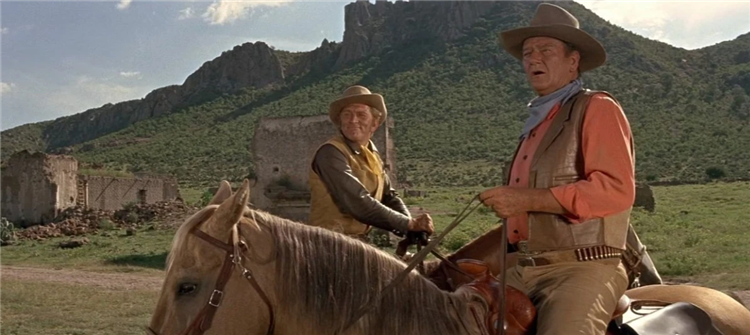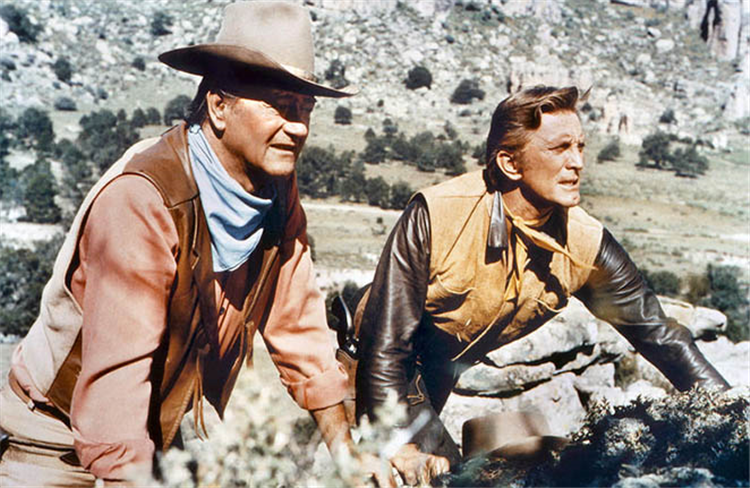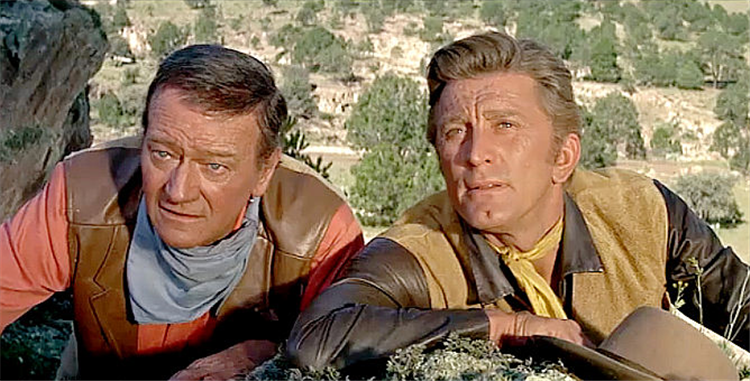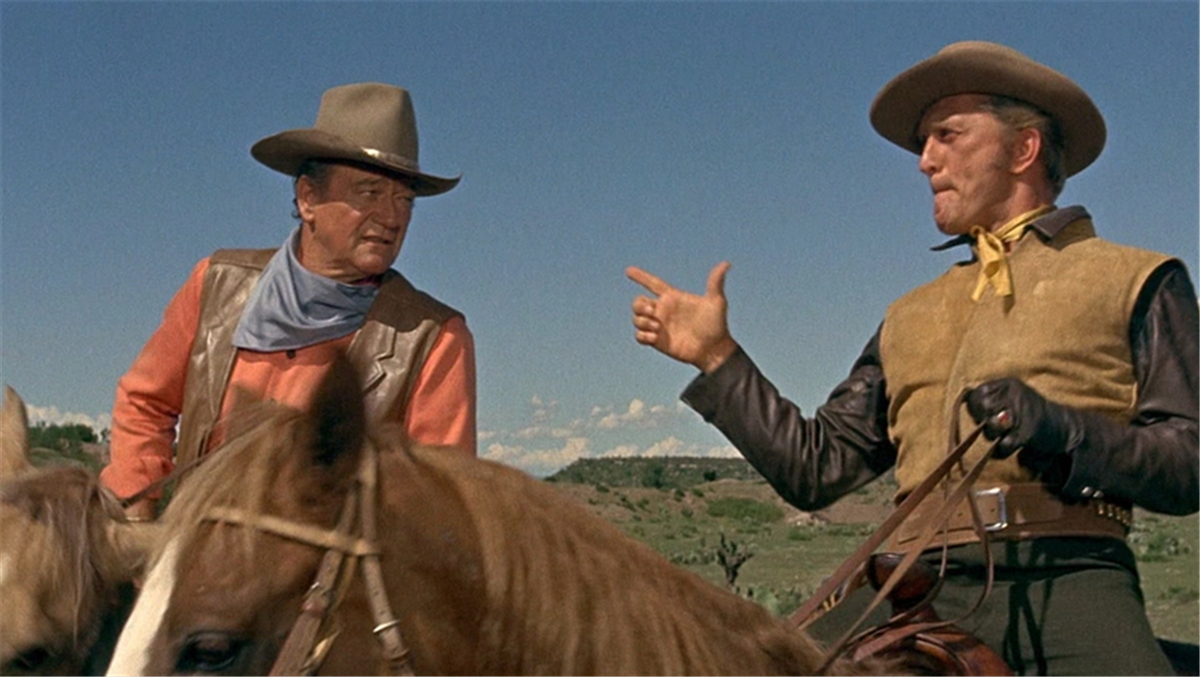The War Wagon(1967), Directed by Burt Kennedy, is a tongue-in-cheek hybrid of a traditional Western, buddy comedy and Heist movie that brought macho superstars, John Wayne and Kirk Douglas, together for the last time.
John Wayne (as Taw Jackson): Did you know why Pierce wanted you to kill me?
Kirk Douglas (as Lomax): Sure, so he could legally steal your land once he found there was gold on it. You were a hard-working rancher defending your property, yet it’s you who gets shot, framed and sent to jail. I always thought that was kind of amusing.
John Wayne (as Taw Jackson): Well, it’s nice to find a fellow with a keen sense of humor.
a conversation between frenemies, Jackson and Lomax from the film, The War Wagon
“Sense of humor” is the right word to describe this star studded Western from Writer, Director Burt Kennedy. Kennedy started out in the 1950s by writing some serious, and seriously brilliant, westerns for Budd Boetticher – the ones known as “Ranown” cycle of westerns starring Randolph Scott: “The Tall T,” “Ride Lonesome” and “Comanche Station”, etc. He would end his career, in the early 1970s, by writing and directing Westerns like “Support Your Local Sheriff” and “Support Your Local Gunfighter,” both starring James Garner, and “Dirty Dingus McGee,” a raucous spoof with Frank Sinatra; films which parodied and rather explicitly lampooned the great Westerns he helped make in the ’50s. The 1967 film, The War Wagon, falls somewhere in between these two kinds of Westerns. On the surface it’s a regular Western, perfectly serviceable for its time; a nice Saturday evening piece of entertainment cooked up by a journeyman director with nothing extraordinary or outstanding about it. It starred two of the biggest (Western) stars of all times: John ‘Duke’ Wayne and Kirk Douglas; a good collection of supporting actors; and a rousing score by genre veteran Dimitri Tiomkin. The film also includes all the expected ingredients (or clichés) of a standard Western: the saloon brawls, the street shoot-outs, the stagecoach chases, the Indian attacks, the bridge-blowing, the evil miners and the righteous gunslinger heroes. But underneath all this, there is always some kind of genre subversion going on, which unlike Kennedy’s later films, are done very subtly and sometimes imperceptibly. The War Wagon was Kennedy’s most ambitious film, it had the biggest budget and the biggest stars he ever had; and the production was backed by Duke’s production company, Batjac. Naturally, Duke was calling the shots on the sets and Duke was a traditionalist, who would not allow anybody to tamper with either the purity of the Western genre or his screen persona. Also, the script of the film is not written by Kennedy – the screenplay was adapted by Clair Huffaker from his own novel, titled Badman. but I’m fully convinced that the script was spruced up by Kennedy, especially the delightful dialogue, which bears his trademark. So without doing any overt genre tweaking. Kennedy positions the film very much on the lines of buddy westerns that Duke was doing a lot at the time; a formula he hit upon after the success of Rio Bravo (1959). The War Wagon may well seem to be a companion piece to El Dorado, another star-studded Western with a lot of humor that was made in the same year, and in which Duke co-starred with another beefy Western star, Robert Mitchum. That was a true-blue western made by a traditionalist like Howard Hawks, but here, Kennedy deftly uses dialogue, characterization and situations to make wry commentary about the Western genre.

The plot of the film looks pretty standard Western; John Wayne seems to be playing the same character he has played many times before (and will play many times again) and wearing the same clothes and riding the same horse. Duke plays Taw Jackson- resident of the town of Emmett, New Mexico – and as the above conversations indicates, Jackson was just a hardworking rancher minding his own business, that’s until gold is discovered on his land. The evil mining tycoon, Frank Pierce (Bruce Cabot) cant wait to get his hands on that gold. And, to this end, he has Jackson shot by professional gunslinger, Lomax(Kirk Douglas); but Jackson survives, so Pierce has Jackson imprisoned on some trumped up charge. While Jackson is in prison, Pierce ‘legally’ grabs his ranch and starts mining gold from the land. The film begins with Jackson returning from prison after spending three years; he gets an early parole for good behavior. Obviously, he has revenge on his mind, but the way he go about with his revenge is what make this film very interesting. In any other ‘John Wayne movie’, he would have stared down the villain, fought him head on and taken back his ranch . Here, he gives off the impression that maybe “the prison took some of the starch out of him“, but clandestinely, he devises another plan to hit back at his tormenter: to steal Pierce’s shipment of gold – that’s technically Jackson’s gold, as it is from his land – when Pierce would transport his largest shipment – about half a million dollars worth of gold dust – from Emmett to the Railroad station in El Paso. Jackson has 4 days to accomplish the heist. This means that the film will be one of those rare occasions where Duke will be playing a ‘Badman‘, someone working against the law. Usually he is the man on the right side of the law. That itself is a kind of subversion, but it is covered up by the fact that the law in Emmett is in Pierce’s pocket, and Jackson being the wronged man is still in the right if he goes against the law in this instance.

But stealing the gold is not easy. The gold is transported through treacherous territory covering 43 1\2 miles in the eponymous “war wagon”. The War Wagon is an armored stagecoach: iron-plated, topped by a turreted Gatling gun and pulled by a team of six horses. The wagon is protected by a total of twenty-eight outriders and five armed-guards inside, each man is armed with a Henry repeating rifle, two Colts and two hundred rounds of ammunition. This exaggerated “gadget” seems to be a nod to, a) the hugely popular James Bond films of the time that was unveiling innovative gadgetry; and b) the very popular Western series, Wild Wild West, featuring the character of “James Bond in the West”, James T. West, which also showcased outlandish gadgets like these. So Jackson has to devise an elaborate plan to steal the shipment. Thus, the film takes on the characteristics of a heist movie: A team is to be assembled, a plan is to be drawn up, rehearsed and put into action. Surprisingly, as the first member of the team, Jackson recruits Lomax, the man who shot him 5 years ago. It’s again a diversion from the established Wayne persona, where he not only makes peace with a guy who treacherously shot him, but also makes him a partner in crime. Lomax, on other hand, is a mercenary in its truest sense, who does anything for money and is eveready to sell his services to the highest bidder.. As Pierce describes him: “Unless there’s money in it, Lomax ain’t goin’ to do nothin’ for nothin’.” Lomax accepts Jackson’s offer as it is going to make him richer by Hundred thousand dollars, and they form an uneasy partnership where each one distrusts the other, but needs to work together to achieve their respective objectives. Meanwhile, Pierce is also trying to hire Lomax’s services- to kill Jackson for Ten thousand Dollars (which he later raises to twelve). Lomax accepts that offer too, but holds out acting upon it until he he see the results of Jackson’s heist plan. Lomax’s ‘double-dealing’ gives an interesting dimension to his already fraught relationship with Jackson; This again is something new, with regards to the buddy-buddy relationships we have seen in Westerns, and provides some of the film’s most amusing moments. But like a lot of interesting ideas in the film, it is not carried to its full extend; we never get a sense of danger: of Lomax’s “Would be Betrayal” hanging over the smooth execution of heist, and are always convinced that he would stick with Jackson’s plan till the end no matter what happens. The fact that Pierce is killed before the actual completion of the heist also dilutes the impact.

Jackson’s team is rounded out by a Kiowa Indian, Levi Walking Bear (Howard Keel), who hates his own tribe and has adopted the White man’s way : “Grab all you can, anytime you can.” ; a drunk explosives expert, Billy Hyatt (Robert Walker Jr.), who has a hard time holding his shakes – yeah, shades of Dean Martin from Rio Bravo (Duke never shied away from repeating a winning formula), but is super steady while handling nitroglycerin; and Wes Fletcher (Keenan Wynn), an old, disgruntled, greedy employee of Pierce (and an obsessively possessive husband of a very young wife, Kate played by Valora Noland) who is stealing from Pierce even before the heist. This is as disparate a group of people you can get and there is lot of tension between them, thanks mainly to Billy, who just cant hold his liquor, and is a constant threat to the secrecy of the planned caper. Billy also makes a play for the young Kate, who seems to reciprocate, much to the chagrin of old Wes. Now the plan Jackson devises is as follows: Levi is to coordinate with his tribe members led by war chief, Wild Horse (Marco Antonio) to help them in the heist in return for rifles, blankets and food. So as the War Wagon is on its way, massed Indians, dragging tree limbs to stir up dust, will create a diversion, drawing the outriders away from the wagon (Lomax seriously doubts whether Pierce and his men would fall for this “old Indian dust trick”, a wry meta commentary) . A second band of Indians will attack the wagon. Once the fleeing wagon crosses a bridge, the structure will be dynamited by Billy, isolating the outriders should they try to pursue. Finally, as the wagon negotiates a pass, a huge tree trunk suspended on ropes will swing down and decapitate the turret and its gun from the wagon. The plan looks solid, but to carry out this plan Billy requires nitroglycerin, which is only available in Jackson’s old Ranch (now belonging to Pierce). So Jackson creates a ruse; he barges into the ranch and holds Pierce at gunpoint demanding Pierce return his old clothes lying in the attic; meanwhile Billy and Lomax enter the warehouse unnoticed and steals the nitroglycerin from the safe. The idea of Duke breaking into the villain’s den just to retrieve his old clothes is one of those bits of genre parody that’s strewn throughout the film.

The last half hour of this 100 minute movie involves the elaborately staged heist sequence, and showcases the exquisite work of stunt coordinator and second unit director, Clifford Lyons, who has worked many times before with Duke, particularly on his directorial venture, The Alamo(1960). During the heist, things go pretty much as planned, but the last leg of the plan goes awry: Pierce, who always travel inside the wagon, is killed by his own guards in panic. Again, it’s one of the rare instances where Duke doesn’t get to confront and kill the bad guy in the climax, and the villain is killed by his henchmen. To make things worse, Jackson looses control of the wagon, and it overturns in a ravine. Lomax – who was specifically hired by Jackson for his safe-cracking skills – opens the safe, and the men move the gold dust into a separate wagon filled with Flour barrels. While the gold dust is being hidden in barrels of flour on Fletcher’s wagon, Wild Horse and his tribesmen show up and try to take it away from them. During the ensuing gunfight, Fletcher is killed and the horses are spooked. They run away with the wagon, and most of the gold is lost as a result. But Fletcher’s greed comes in handy here; he had stolen a couple of gold bags and hidden in a secret shelf in his wagon, which, unknown to Lomax and others, is discovered by Jackson. Lomax later finds out about the retrieved gold and angrily confronts Jackson about its whereabouts. Jackson tells him to wait for six months, as “it wouldn’t be very smart to flash gold dust around right after a robbery” – something that Lomax himself had insisted upon earlier. The last bit of dialogue between these two perfectly sums up their relationship and the film:
Lomax: How much is there and what did you do with it?
Taw Jackson: A hundred thousand. I hid it.
Lomax: Where?
Taw Jackson: I’ll let you know in about six months.
Lomax: Six months? I want it now!
Taw Jackson: Now it wouldn’t be smart to start flashing gold dust around right after a robbery would it?
Lomax: What am I supposed to do in the mean time, huh?
Taw Jackson: Well, for one thing, you better make damned sure I stay alive.
Lomax: That’s a twenty-four hour a day job!
Taw Jackson: That’s your problem… partner.
The film ends on this note: with Jackson riding away, and the ever agile Lomax missing a leap onto his horse for the first time (in the movie) and eating dust.

In a film starring Duke, it is very difficult for any other actor to makes his presence felt, but Kirk Douglas almost steals the picture here. Dressed in black leather (how does he handle it in the New Mexico heat?) and a yellow neckerchief, he is agile, athletic, cheeky, sarcastic, confident, and all charm and smooth, physical grace. Douglas seems to have modelled his performance after his legendary swashbuckling namesake, Douglas Fairbanks Sr. ; he hardly ever gets on or get off a horse, he leap across other horses to mount his own and then leaps out onto cliff faces and top of buildings. showing off a high level of fitness. Though Duke and Kirk were on the opposite sides of the political divide, it never came between their personal friendship or their working relationship. They have great chemistry together; They play off each other very well, and the terrific dialogue goes a long way in making their interactions delightful. Duke, at the time , was in poor health. He was just recovering from having lost a lung and a few ribs to cancer. He needed constant oxygen supply to breathe, and he was finding it difficult to get on and get off horses. But one doesn’t realize all this from his performance, which is as solid as it can be in these sort of films. The film was photographed by Duke’s regular cinematographer, William H. Clothier, who delivers crisp and dynamic screen images of the beautiful Mexican landscape, though it does not match the great visuals he had created for John Ford. Kennedy was never a great visual director, his strength was dialogue and working with actors. By the way Clothier retired in 1972 after shooting The Train Robbers, which was the next Wayne Western directed by Kennedy. The film does look dated from some angles; especially the casual racism and sexism; one of the early scenes featuring Lomax in his “Oriental Palace” finds him with two Chinese girls, who are obviously his “sex slaves”; one scene where they take off his boots has him kicking the girl’s behind to get the shoes off. Casting of Howard Keel as an “injun” also looks rather cheesy. Then there is that title song; the film opens with one of those bombastic, cheesy title songs that was a regular feature of the Westerns right until the 70s.; “Ballad of the War Wagon,” written by Dimitri Tiomkin and Ned Washington is sung by Ed Ames. By the way, this would be the last time when genre veteran, Dimitri Tiomkin would compose music for a Western.
